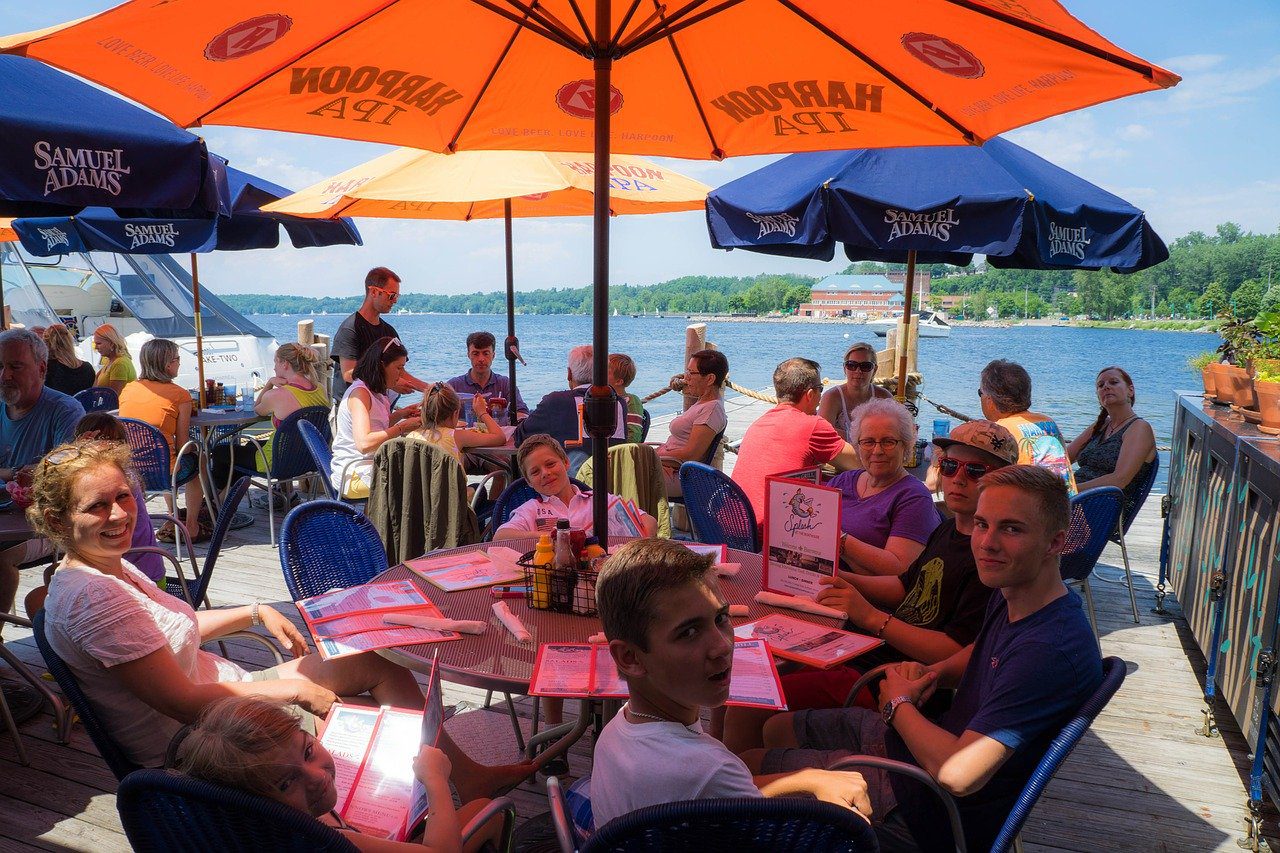
Dining rooms are opening and closing across the country, but sitting outside is among the safest ways to eat out during the pandemic, experts say. With long days and warm temperatures, the demand for outdoor dining is at a new high.
We asked restaurateurs from coast to coast how they have adapted their operations to the new al fresco normal – try these tips for success.
- Take advantage of relaxed permitting.
From New York to Chicago to Los Angeles, U.S. cities have relaxed and streamlined processes for obtaining outdoor dining permits. Johan Botma of Sfoglia applied for New York City’s Open Streets program, which allows restaurants to apply online and self-certify to temporarily expand their outdoor seating. He applied on a Friday, was quickly approved, and started serving tables outside the following Monday.
In other cities, like San Francisco, restaurants are moving to close streets for outdoor dining, shutting down car traffic for more table service. Even if your sidewalk space is limited, check your local regulations to see what’s possible.
- Start slow, then grow.
Before New York reached Phase 2 of reopening, Sfoglia was open only for takeout and delivery, and the team placed a few tables outside the restaurant for people to enjoy their to-go meals. On June 22, they were allowed to begin table service outside and grew to eight tables. After an overwhelmingly positive response from guests, Botma hired his cousin, a contractor, to build a deck. Today, they serve 17 tables outside.
“People were excited to come out and appreciative that we had opened, and we just grew – we are making adjustments by the moment,” Botma said.
- Embrace your surroundings.
At 50% capacity or less, Houston’s B.B. Lemon could only seat about 12 inside the restaurant, but outside is a 1,500 square-foot yard lined with trees and a fence. To utilize the space, the team purchased cabanas to fill with private tables and lights, creating a luxurious, resort-like atmosphere.
“It’s almost like a garden party every night, with spacing for tables,” said founder Benjamin Berg. “If they are all full, we can seat more than 80 people, and everybody is still 10 feet away from each other. You don’t feel like you’re in a restaurant in the middle of a city.”
Similarly, Ryan Cole is a partner at San Francisco’s The Vault, which sits in a building that occupies a whole city block – including a massive plaza. With The Vault closed, his team built an entirely new restaurant in a section of the plaza, utilizing the space’s bamboo garden: The Vault Garden.
“We didn’t have to physically pivot the space to accommodate the guidelines,” said Cole. “Our partnership with the building allows it, because it’s a great use of the space.”
- Heed safety and distancing guidelines.
Whether indoor, outdoor, or to-go, safety regulations are top priority for any dining experience now. Distancing and sanitation protocols should guide any decisions you make about table layouts and steps of service.
Cole enlisted a designer’s help from the start to map out a floor plan for The Vault Garden, making sure the materials and layout complied with safety codes. Botma’s construction team did the same for Sfoglia’s deck. Each restaurant insists on a “bubble” between tables to avoid any unwanted or unnecessary contact between guests and staff.
- Set expectations with guests up front.
“We designed our restaurant to make it as safe as humanly possible,” said Cole. “You should come and expect rules for your own benefit.”
In outdoor spaces, guests may not know when to wear a mask, how to move around, or what to expect generally. Hosts at The Vault Garden give each guest who enters a menu and the card above, which details exactly how the process will work and what everyone needs to do to remain safe. Consider the protocols a two-way street, and don’t be shy about over-communicating with guests.
- Invest wisely in outdoor décor.
A financial crisis is hardly the time to buy new décor, as Botma noted – his outdoor space was built on a “nonexistent budget,” he said. But any investments you make in additional seating will pay off in additional sales.
Out of desperation, Botma initially pulled his vintage wood dining room tables outside. Those aren’t weather-proof, so eventually he landed at Home Depot, where he shopped early morning for lights, extension cords, and tables. After digging at multiple locations, he found enough gorgeous matching mosaic tables to build a cohesive seating area without breaking the bank.
Berg used a simple ROI calculator when planning B.B. Lemon’s outdoor spaces. Though the cabanas, tables, and solar-powered lights required a significant initial purchase, he said, “we could pay for it in one day” of outdoor service.
- Create an atmosphere that reflects your brand.
Of course, not just any tables and chairs will do – a successful outdoor experience should feel like an extension of your typical restaurant vibe. “Think about the whole package,” Berg advised. “Make it something that’s desirable, where people really want to be – not just where they’re forced to be because they feel it’s safer.” Two guests have proposed marriage at B.B. Lemon since they installed the cabanas, which is unprecedented for the restaurant.
Botma bought blue umbrellas to match his outdoor tables, creating a “colorful oasis at night,” he said. San Francisco summers rival winters in the rest of the country, so The Vault Garden offers single-use blankets and disposable heat packs to make people more comfortable outside. Think about the whole experience and what you can do to make it feel not just safe, but cozy and special.
- Extend your floor plan outside.
With dining rooms closed, more restaurants offer reservations for outdoor tables. In OpenTable, you can categorize existing tables as outdoor, add new outdoor tables to your existing floor plan, or create an entirely new plan for your outdoor seating. Here’s how.
By carefully managing your tables outdoors, you can more accurately adjust your reservation availability. Making outdoor tables reservable allows you to set expectations with guests, so they know they’ll get the royal treatment that they’re used to inside your restaurant.
Plus, outdoor reservations provide more predictability around how many guests you’ll seat, so you can order accurately and avoid both waste and unexpected crowds. You can even do more turns in a service by keeping every table status up to date.
- Adjust your food and drink menu.
Especially when first starting outdoor dining, consider scaling down your food menu to house favorites and adding items over time. For Botma, a limited menu allowed Sfoglia to be conservative in waste and monitor business. Weather is a factor, too – dishes like panzanella salads and semifreddo desserts are easy to execute with a limited staff and taste perfect al fresco.
The Vault Garden built an entirely new menu designed for outdoors. The restaurant’s kitchen sits on the other side of the block, so runners have to carry plates and trays up and down stairs, making travel a challenge. They designed cocktails to be pre-batched and poured into high-end plastic glasses to avoid breakage.
- Get the word out.
Many guests are eager to dine at restaurants again, but they don’t always know that their favorites are open for business. Post photos of your new spaces and menus on your social media channels and other online profiles (including your OpenTable photo gallery) to show people what they can expect from the experience.
Lean on other neighborhood resources, too. Botma contacted local forums, businesses, and radio programs in his area to build buzz about Sfoglia’s setup, which was just listed among the city’s best outdoor dining options in the New York Post – “phenomenal exposure,” he said.
When The Vault Garden opened, Cole hired a PR firm and invested in paid marketing. “In the long run, we need to fill hundreds of seats a day,” he said. “We have to figure out how to work within this. We’re treating it like a regular restaurant, not five tables on the sidewalk that can’t sustain a business.”
Visit our preparedness resource center for additional COVID-19 information.
OpenTable, part of Booking Holdings, Inc., powers reservations for the hospitality industry. OpenTable’s software seats more than 1 billion people per year and helps more than 60,000 restaurants, bars, wineries and other venues attract guests, manage capacity, improve operations and maximize revenue.
OpenTable, Inc. www.opentable.com
1 Montgomery, 7th Floor/San Francisco, CA 94104





Recent Comments